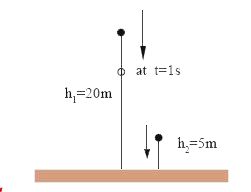Two bodies reIeased from different heights fall freeIy and reach the ground at the same time. The first body takes a time,t1=2s and second body takes a time, t2=1s. What was the height of the first body at the time of reIease of the second body? Solution in Bengali
Let the height from which the first body is released be h1 above the ground. When it is at a height h2 the second body is released .
So, the first body falls through a height (h1−h2) in time (t1−t2) before the release of the second body. According to the problem,
h1=12gt21 and h1−h2=12g(t1−t2)2
or, 12gt21−h2=12g(t1−t2)2
or, h2=12g(2t1−t2)t2
=12×9.8(2×2−1)×1=14.7m.

Topper's Solved these Questions
- BOOK - CHHAYA PUBLICATIONCHAPTER - ONE - DIMENSIONAL MOTION EXERCISE - Section Related Questions17videos
ONE - DIMENSIONAL MOTION
- BOOK - CHHAYA PUBLICATIONCHAPTER - ONE - DIMENSIONAL MOTION EXERCISE - HIGHER ORDER THINKING SKILL (HOTS) QUESTIONS35videos
ONE - DIMENSIONAL MOTION
- BOOK - CHHAYA PUBLICATIONCHAPTER - NEWTONIAN GRAVITATION AND PLANETARY MOTIONEXERCISE - CBSE SCANNER19videos
NEWTONIAN GRAVITATION AND PLANETARY MOTION
- BOOK - CHHAYA PUBLICATIONCHAPTER - QUESTION PAPERS OF NEET -2017EXERCISE - QUESTION32videos
QUESTION PAPERS OF NEET -2017
Similar Questions
Define rest and motion.
02:33View SolutionCan a partical, moving with a uniform speed have a non-uniform velocity?
02:46View SolutionWhat is the reason for absence of atmosphere in some planets?
02:03View SolutionA molecule of a substance has permanent dipole moment p . A mole of this substance is polarised by applying a storg electrostatic field E . The direction of the field is suddenly changed of 60∘ . If N is the avogadro's number the amount of work done by the field is
06:48View SolutionA body is allowed to fall from a height of 10m. If the time taken for the first 50m is t1 and for the remaining 50s,is t2.
The ratio of time to reach the ground and to reach first half of the distance is .03:48View SolutionTwo bodies begin to fall freely from the same height but the second falls T second after the first. The time (after which the first body begins to fall) when the distance between the bodies equals L is
05:15View SolutionA body is falling from height 'h' it takes t_(1) time to rech the ground. The time taken to cover the first half of height is:-
03:23View SolutionA body falls freely from a certain height. It takes times t_(1) and t_(2) to travel the first and the first and the last half -distances, respectively. Then
05:15View SolutionA body is released from the top of a tower of height metre. It takes time T seconds to reach the ground. Where is the body at time T2seconds?
View SolutionTwo bodies fall freely from different heights and reach the ground simultaneously. The time of descent for the first body is t1=2s and for the second t2=1s. At what height was the first body situated when the other began to fall? (g=10m/s2)
 View Solution
View SolutionTwo bodies fall freely from different heights and reach the ground simultaneously. The time of descent for the first body is t_(1) = 2s and for the second t_(2) = 1s . At what height was the first body situated when the other began to fall? (g=10 m//s^(2))
View SolutionTwo bodies fall freely from different heights and reach the ground simultaneously. The time of descent for the first body is t1=2s and for the second t2=1s. At what height was the first body situated when the other began to fall? (g=10m/s2)
 View Solution
View SolutionTwo bodies fall freely from different heights and reach the ground simultaneously. The time of descent for the first body is t1=2s and for the second t2=1s. At what height was the first body situated when the other began to fall? (g=10m/s2)
 View Solution
View SolutionA body of mass 2kg is projected from the ground with a velocity 20ms−1 at an angle 30∘ with the vertical. If t1 is the time in seconds at which the body is projected and t2 is the time in seconds at which it reaches the ground, the change in momentum in kgms−1 during the time (t2−t1) is
03:29View SolutionA body of mass 2kg is projected from the ground with a velocity 20ms^(-1) at an angle 30^(@) with the verticle. If t_(1) is the time in seconds at which the body is projected and t_(2) is the time in seconds at which it reaches the ground, the change in momentum in kg ms^(-1) during the time (t_(2)-t_(1)) is
02:44View Solution

